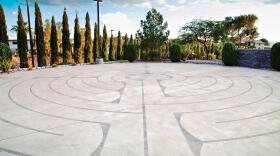The Smith Center’s big, brash pipe dream
The Smith Center for the Performing Arts is a stately limestone building whose classical composition — both elegant and formal — features Art Deco details drawn from Hoover Dam, suggesting enduring social purpose and monumental achievement. Indeed, the newly opened center has already attracted a constellation of star talent. But the most exciting performer could be found outside the building.
It’s a public art installation by Tim Bavington — his first — called “Fanfare for the Common Man.” It’s a colorful reinterpretation of composer Aaron Copland’s 1942 song of the same name, scored for brass and percussion. The perennially popular song has been re-recorded by Styx and Bob Dylan, among others.
“I like to pick songs that have been redone many times,” says British-born Bavington, a downtown denizen. “I love that it’s a part of the culture.” His own sculptural version of Copland’s quintessentially populist song brings color, energy and brawn to the insistent seriousness of The Smith Center’s architecture.
[HEAR MORE: Tim Bavington discusses how he turned music into sculpture on " KNPR's State of Nevada."]
“He’s the only person I know who translates music into art — transposing musical pieces into vertical lines or varying colors and widths. The fact that he is local, collected around the world and a significant artist made him the perfect person to create the art sculpture outside,” says Myron Martin, The Smith Center’s president and CEO.
Bavington’s rendition consists of 80,000 pounds of enamel-coated steel pipes sandwiched together as a gently arcing backdrop for Symphony Park, the green space that abuts the Smith Center. Appropriately, it resembles a pipe organ similar to those found in grand cathedrals. Each musical note of Copland’s composition is symbolized by a tubular stripe of corresponding shade, width and height. Sound is translated from ear to eye with mathematical precision, abstracted in a vertical sequence similar to notes on a music scale. The curving installation measures 86 feet long, 17 feet deep and up to 27.5 feet high. The 128-pipe sculpture is double-lined with ground lights every two feet, representing the 40 bars found in sheet music.
“The deployment of color, shape, and interval has its own internal machinery,” art critic Dave Hickey wrote of Bavington’s work, which he nurtured while teaching at UNLV. “There is always logic, in other words, but never a plan.”
Bavington employed both logic and planning by using automotive paint for the sprightly shaded arrangement, giving it the rigor and resilience needed to withstand Southern Nevada’s weather. He also takes the music inside: A scaled-down, polymer canvas version resides inside Smith Center’s Reynolds Hall.








